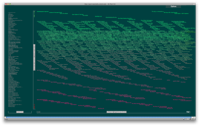 Still Water’s John Bell and Jon Ippolito presented good news for underdogs everywhere at the NetSci 2010 conference, held last May at Northeastern University. Bell and Ippolito argued that the dynamics of creative networks may work to lessen inequalities that first appear when leaders in social networks receive high ratings. The findings are based on a study of student use of The Pool, a collaborative network where success is an emergent property of feedback from one’s peers.
Still Water’s John Bell and Jon Ippolito presented good news for underdogs everywhere at the NetSci 2010 conference, held last May at Northeastern University. Bell and Ippolito argued that the dynamics of creative networks may work to lessen inequalities that first appear when leaders in social networks receive high ratings. The findings are based on a study of student use of The Pool, a collaborative network where success is an emergent property of feedback from one’s peers.
At any given time about 300 students in universities across the U.S. are active in The Pool, proposing ideas, building projects, and reviewing each other’s progress. Right now most are from the University of Maine, USC, and the UC Santa Cruz. The Pool currently tracks 6000 reviews of over 2000 examples of creative work in art and code.
The Pool departs from a conventional social network in that the primary nodes are creative projects rather than people; Pool users themselves are indirectly connected to each other via their collaborations on or reviews of each other’s projects. In fact, a node has several measures of connectedness, such as the number of contributors, the number of reviews, or the number of relationships to other nodes. That said, a node’s success in The Pool is typically measured not by the number of connections but by the average approval bestowed by its reviewers.
Bell and Ippolito were initially concerned that The Pool would evolve into a so-called “aristocratic” network, in which student projects with the highest ratings would simply attract higher and higher ratings with time. But they found that didn’t happen. There seems to be a mechanism at play, unintended by its creators, that keeps the most active projects from getting rated too highly.
It turns out there are many real-world networks that similarly resist the “rich get richer” paradigm, whether woven from worm neurons, electrical relays, or airline routes. Social networks aren’t a panacea for education’s ills, but when harnessed for creative ends they remind our students that there are alternatives to the hierarchies of academia and capital.
You can read a meshed version of the presentation here:
“When the Rich Don’t Get Richer: Equalizing Tendencies of Creative Networks”
